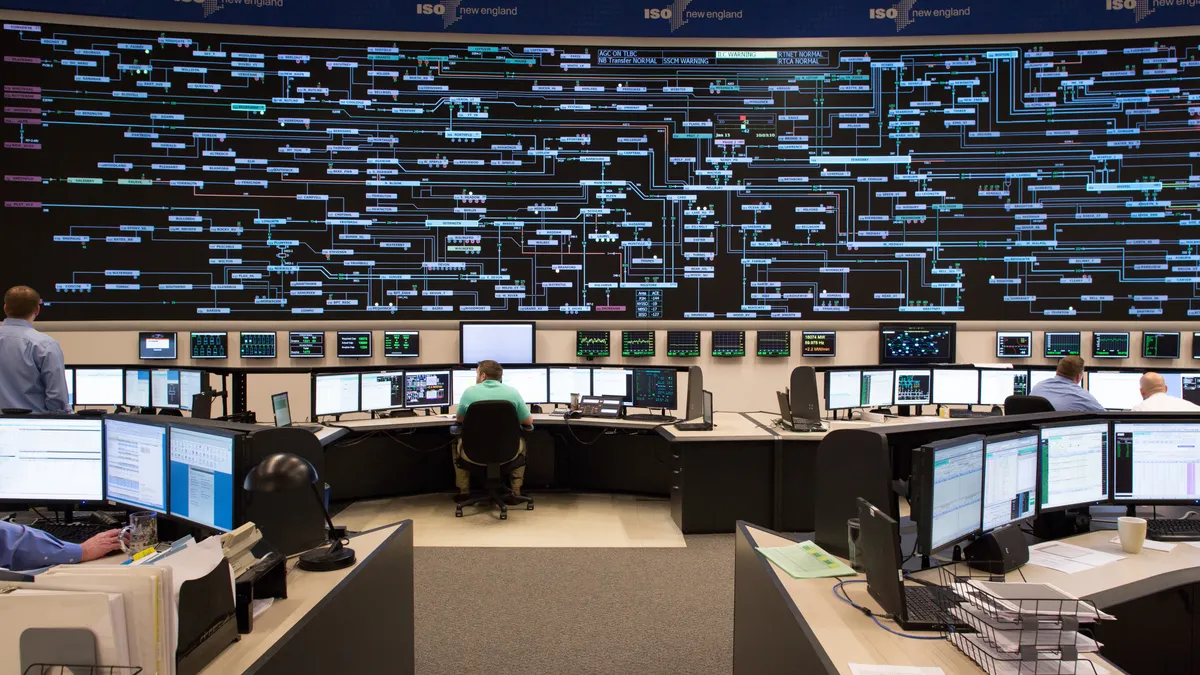Dive Brief:
- Generators, transmission utilities and others support, with some conditions, ISO New England’s application to the Federal Energy Regulatory Commission to establish a storage as transmission-only asset, or SATOA.
- The New England States Committee on Electricity told FERC it supports ISO-NE’s application and electric storage facilities as transmission-only assets “should enhance the competitiveness of future solicitation processes, ultimately resulting in more cost-effective transmission solutions and benefits to consumers.”
- Advanced Energy United, an industry association, said it supports approval of the SATOA proposal and urged ISO-NE and FERC to view it as a “first step and learning opportunity” for a “more robust and flexible” use of energy storage.”
Dive Insight:
ISO-NE said in its application to FERC that SATOA would be activated to relieve the strain on a surviving transmission line after others were knocked out by a storm or during controlled outages. It’s looking to establish a SATOA rule by July 1, 2024, and asked FERC to approve its request by March 29.
FERC has recognized that electric storage facilities may serve as transmission assets under some circumstances for greater efficiency and cost-effectiveness, ISO-NE said in its Dec. 29 filing. Beginning in 2010, FERC, in orders and policy statements, “opened the door” for consideration of electric storage as transmission assets, ISO-NE said in its filing.
The proposed change would establish a separate class of energy storage resources that would not participate in the wholesale markets and would have a minimal impact on wholesale electricity prices.
By integrating a storage resource into transmission equipment, storage-as-transmission can add or absorb electricity for power flows on transmission lines over a period of time. Storage used this way can add to transmission line capacity or serve as an alternative to building transmission projects, according to American Clean Power.
Advanced Energy United said ISO-NE’s proposal limits the use of SATOAs that could “constrain deployment of energy storage in New England as a tool to cost-effectively meet system needs.” For example, limiting SATOAs to participation as transmission-only assets and not allowing any market participation would prevent full use of the assets, AEU said.
The New England Power Generators Association told FERC it does not oppose ISO-NE’s application. It asked FERC to request that the ISO-NE internal and external market monitor evaluate and report on price suppression related to the dispatch of SATAOs and the competitiveness of SATOA solicitations.
First Light Power, a Burlington, Massachusetts, owner and operator of about 1,400 MW of hydroelectric generating facilities, including pumped storage hydroelectric plants and lithium-ion battery installations, also said it’s not against the application. But it said it would “strongly oppose” efforts to expand SATOA operations that could have an adverse impact on First Light Power’s pumped storage resources relying on competitive market revenue.
Vermont Electric Power Co. and Vermont Transco support ISO-NE’s application. But it called for modifications including eligibility for SATOA for selection as the preferred solution to provide dynamic voltage support in all studies that identify system voltage needs.
“VELCO believes the use of SATOA for voltage support is a segment of the main use case . . . detailed by ISO in its filing and should be allowed to stand equally as a preferred solution where studies show there are voltage violations,” the utility said.
The New England States Committee on Electricity told FERC it supports ISO-New England’s application and electric storage facilities as transmission-only assets “should enhance the competitiveness of future solicitation processes, ultimately resulting in more cost-effective transmission solutions and benefits to consumers.”
The Union of Concerned Scientists said ISO-NE’s approach “omits the opportunity for transmission upgrades that can be made by large generators using storage.”
FERC should address transmission functions available from storage more broadly than what ISO-NE has proposed, it said. The scientists’ group urged FERC to use its decision authorizing ISO-NE’s SATOA to make storage-as-transmission a “technology solution that can expedite the construction of grid facilities for generation as well.”














